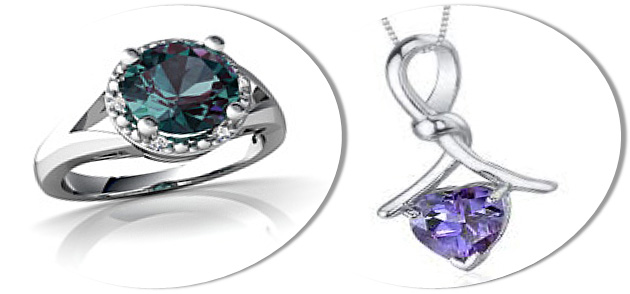Alexandrite - The June Stone
Alexandrite makes a wonderful choice for a "change-loving woman", who loves red and green. It is the birthstone of June with Pearl being the other one.
This gem was discovered in Russia in 1831 on the day Czar Alexander II attained majority - hence the name. With mohs scale value 8.5, this gemstone is durable and suitable enough for all kinds of jewelry including everyday wear rings.
Symbolism
In old imperialist Russia, where the national colors also happened to be green and red, this stone was considered a very good omen. It is said to promote spiritual growth by balancing mind and emotions and calming soul.
It has been known to boost confidence and self-esteem. It is believed to intensify the feelings of compassion, love and sensuality, while being considered the symbol of joy and good fortune.
Colors and Facets
Member of chrysoberyl mineral family, alexandrite is a fascinating, transparent
gem with a unique feature of appearing greenish-blue to dark yellowish-green in daylight and
pink to raspberry-red under incandescent light. Due to this unique optical properties, it has been characterized by poets as "an emerald by day, a ruby by night", and regarded highly among fine quality gems.
The intensity of its color change is the most important factor that is taken into consideration while evaluating this gemstone. The more intensive and complete the color change, the rarer and more valuable the stone is.
While large stones are very rare and
expensive, smaller ones (below 5 carats) are also very expensive if
the color change is strong. Other gems such as some garnet and spinel also display color-changing phenomena and said to have "the alexandrite effect".
This stone is normally cut in a faceted style, but some Cat’s Eye types, found in Brazil are cut as a cabochon to display the eye- effect. However, those are usually small. It is a pleochroic gem, showing different color intensity when viewed at different angles, and this factor must be taken into account during its cutting job.
Cat's Eye
Clarity of this gem varies from eye-clean to heavily-flawed with inclusions. Clarity is also a factor while doing valuation of stone, but color-change is the primary consideration.
Sources
This gemstone was first discovered in
Sanarka River in the southern Ural mountains of Russia in 1831, but is
mined today primarily in Sri Lanka, Zimbabwe, Brazil, Burma, Madagascar
and Tanzania.
When Russian mines were exhausted of this wonderful gem and stones extracted from new sources were not coming with same vivid-colored and color-changing qualities, people somewhat lost interest in this beautiful stone.
However, things changed radically with discovery of alexandrite deposits in Brazil in 1987. Gems from these deposits were found to be of high quality with excellent optical properties along with good color and clarity. Brazilian mine has since then become very important in terms of economic terms making this gem easily available in the gemstone market.
Uses
Medicinal
The healing properties of this birthstone are known to be effective for health problems related to pancreatic and chronic disorders. It is said to improve blood circulation of wearer by purifying blood and strengthening blood vessels.
Practitioners of crystal healing believe this stone is helpful in regeneration of neurological tissues and in treatment of leukemia. It is also recommended to patients recovering from surgery.
Ornamental
Beautiful and top-quality alexandrite is very rare in nature, and you may not find it frequently in contemporary jewelry. In jewelry, this jewel is used as ring and pendant centerpieces, and usually jewelry with Russian stones fetch higher price.
In terms of price, large-sized stones are comparable with rubies and emeralds of similar size. So, don't think this gem to be any lesser than higher-end gems.
Things to Remember
Although it is not treated or enhanced, but it can be difficult to distinguish natural and synthetic varieties from each other. From 1973 onwards, good quality synthetic alexandrites are being produced which are not easily distinguishable from the real ones. Due to this, many fake stones are mistaken for real gems.
But, if you take the gem to an expert gemologist, he will tell you the difference. So, before buying, verify the authenticity of this jewel, since it might have been mistakenly identified years ago and passed along as the real thing to you today.
One may believe to have a genuine alexandrite, but may actually have a synthetic sapphire treated with chemicals to show a bluish to violet color change.
This gemstone should be protected from prolonged exposure to excessive heat as this can adversely affect the stones color change phenomena.
Return from Alexandrite to Birthstone Jewelry
Return from Alexandrite to Diamond Jewelry Homepage
I hope you'll not mind sharing this on Twitter, Facebook and with everyone else :)
Feel free to share if something is in your mind and want it to be covered on this site.
My Newsletter
Did you liked this article? Sign-up my FREE weekly newsletter and I'll send you more awesome new additions on this website along with latest jewelry happenings around the world, and download my Jewelry Design Album for FREE!
 |
|





